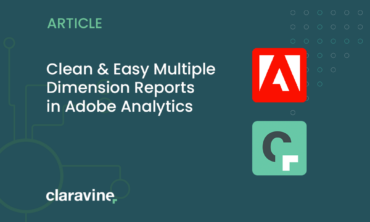Digital analytics data enrichment [business uses from expert Adam Greco]
Digital data is more important than ever in today’s business landscape. The most traditional aspects of business have moved online, and businesses are clamoring to record and strategically use every click made by consumers. Organizations pour hundreds of thousands of dollars to build digital analytics implementations in hopes of streamlining their data collection and gaining a competitive advantage.
Unfortunately, many organizations don’t utilize an entire category of data: digital experience metadata. This restricts receiving important context around decision-making and impairs organizations’ ability to ensure campaigns and content drive results with optimal efficiency.
Here we introduce the benefits of investing time in digital analytics data enrichment and provide a few ideas on which business uses to consider first.
Data Enrichment
Data enrichment is a broad term referring to any process that results in improvements to raw data in order to make that data more valuable to the business. Usually, this means additions to the data that make it easier to process, understand, and draw conclusions from.
Data enrichment fits under the larger umbrella of data management (particularly of quality assurance). Similar data management elements that might be included with data enrichment could include data cleansing, quality assurance, or data integrity processes.
Digital Analytics Data Enrichment
Data enrichment in the context of digital analytics is the process of expounding on the natively captured data elements in digital analytics tools. While many organizations currently recognize the importance of acquiring data and conducting digital analytics in order to improve their business, they often overlook data enrichment.
Sometimes referred to as ‘metadata’, data enrichment allows organizations to supplement the data they are collecting via tagging with additional data (e.g., campaign, customer, and experience details) that can help improve conversion rates and overall digital experiences.
Regardless of the type of metadata involved, digital analytics data enrichment allows organizations to improve their digital data analyses. Chief benefits of added (and quality) metadata include:
- Access to more insights via additional report breakdowns
- Increased opportunities to segment audiences
- Greater overall return on investment from your digital analytics program
- Opportunities to avoid manual data transformation and quality tasks on the back end
Benefits of Digital Analytics Data Enrichment
You may come from an organization that already captures lots of data natively from your users or customers. Why should you care about adding metadata elements? A couple of ways you can use data enrichment to your advantage include:
Data Aggregation
The expression ‘you can’t see the forest for the trees’ is true of data aggregation too. The proper application of metadata allows you to dig yourself out of (often confusing) details to view the bigger picture of your data through aggregation. New, valuable insights are ready for you to uncover with these groupings.
If you have a spreadsheet of data showing sales by city. Viewing 5,000 rows of data makes it impossible to see how cities, states, or regions are performing. If you pivot the data by city or state, you can start to see which areas are performing well.
Aggregate data into higher-level buckets and you’ll find meaningful insights to help point your business in the right direction and indicate how to invest for a return.
You run into the same principle in digital analytics. Organizations typically capture massive amounts of data in digital analytics tools, but finding meaningful and granular insights is more complicated.
Example: You have three million external campaign tracking codes. With detailed tracking code data, you can see which campaign elements are doing well. However, you still have problems viewing how whole campaigns or marketing channels are over or underperforming. Applying metadata to each campaign tracking code:
- Gives visibility into which channels are working or how effective certain messaging is across multiple types of campaigns.
- Allows you to dissect campaigns and then drill down into specific tracking codes.
- Helps you identify where to spend marketing dollars, and where to save them by defunding under-performing campaigns, campaign messages, and individual campaign elements.
Personalization
If you’ve visited Amazon recently, you’ve seen examples of personalization (and the demand for it). Bottom line: website and mobile app visitors want and expect to have personalized experiences. In fact, most consumers are willing to trade their personal data for these experiences. For example, if I’m mostly interested in sports news, I might expect that, over time, my favorite news vendor site will start delivering that relevant content earlier in my session on the main page of the site.
Data enrichment is a great way to implement personalization on your website or mobile app. If your organization has a CRM system or customer data warehouse, the odds are good that you also have valuable customer metadata that you can leverage for personalization.
Adding customer metadata to your digital analytics implementation can yield several beneficial views, for example, how customer journeys differ by customer segment and make changes to improve conversion for key segments. Another example of how to use this data would be to promote different products or services based upon past purchase behavior.
Data Enrichment Use Cases
External Campaigns
Adding metadata to external campaigns is the most common and familiar way analytics and marketers are introduced to data enrichment. This is mostly because most digital analytics tools provide a built-in external campaign component. Most of the time, you will assign campaign tracking codes to:
- Paid search
- Display advertisements
- Social media campaigns
- Email campaigns
You can include metadata attributes including (but not limited to) Marketing Channel, Campaign Owner, and Campaign Objective. These will help you dissect campaign results later. For a more detailed resource on external campaigns, you can view Keys to a Best-in-Class Adobe Analytics Classification Process Webinar from the DAA Webinar Series.
Internal Campaigns
You can recognize an internal campaign by banners or links on web pages that send visitors to specific products, product categories, or landing pages. Internal campaigns are also referred to as internal or onsite campaigns.
Similarly to external campaigns, you can assign a different type of unique tracking code to internal campaign elements. The unique code is passed to a native digital analytics dimension after a user clicks on one of these codes.
The internal campaign codes can have metadata attributes applied. Metadata attributes could include:
- Internal Campaign Name
- Internal Campaign Type
- Internal Campaign Owner
- Internal Campaign Location
- Internal Campaign Reason (e.g., Sales, Marketing, A/B Test, etc.)
These attributes are used in digital analytics reports to see how each drives KPI’s and conversion.
Products and SKUs
In digital analytics tools, products are typically captured in a Product dimension. SKUs are derivations of the product. Tracking SKUs as a separate dimension is best to view how product versions perform.
Many organizations have extensive data about their products and SKUs. For example, Product Name, Category, or Division. Product SKUs also have attributes like SKU Color, Category, Division, Name, and so forth.
The addition of metadata attributes to products and SKUs allows digital analysts to include more data points in their analysis. Essentially, this means they can produce more granular and specific reports, breakdown reports, and segments. The new information would help indicate what products and product types were performing better than others. ROI gains could be sought by:
- Promoting specific products
- Modifying product cross-sells
- Adding category-specific promotions.
Customer ID
The application of metadata, in this case, is frequently underused. However, utilizing customer data is critical, and helps with personalization efforts, re-targeting and cross-sell. It’s really the ‘low hanging fruit’ of metadata because it helps maximize the revenue from clients you already have, which is less taxing than adding more.
So if this is such an important category, why is it overlooked? Mostly, digital analysts get stuck in digital marketing silos, and marketing and customer teams rarely interact. As a result, customer metadata gets overlooked in data warehouses or CRM systems such as:
- Original Customer Acquisition Date
- Total Customer Lifetime Value
- Last Product Purchased
- Customer Demographics (Age, Gender, # of Kids, etc.)
In addition to adding valuable granularity to analytics reports, you can use customer metadata and segments to personalize the website or mobile app experiences. Using a testing and personalization platform, you can push segments to the testing platform and show different content to different segments of visitors.
Here are a few ideas (from an endless list of options) of personalized opportunities that result from turning customer metadata into discrete segments:
- For loyal customers: push cross-sell or up-sell items or loyalty discounts
- New customers: push introductory offers
- Unhappy or Inactive customers: personalize with win-back campaigns
Conclusion
Collecting the right data related to your digital properties is more important than ever. In addition to the data natively collected in digital analytics tools, the enrichment of that data provides an opportunity to make the most of your investment in the form of increased ROI opportunities. Invest some time into identifying what additional attributes are available to add to your digital analytics dimensions – you have the potential to increase your overall analytics capabilities in the long run.
For more details and examples on how to understand and use digital analytics data enrichment, see Adam Greco’s in-depth eBook.
To learn how Claravine helps you manage all of this marketing metadata, get started here.
About Adam Greco, Co-Author
Adam Greco is a leader in the digital analytics space and has been helping organizations with digital analytics for over twenty years. Adam was one of the early employees at Omniture (now Adobe) and is the author of the book on Adobe’s analytics product. Adam has managed digital analytics at CME and Salesforce.com and has provided consulting around digital analytics for several leading firms. Adam is an advisor to Claravine.
To learn how Claravine helps you manage all of this marketing metadata, get started here.



